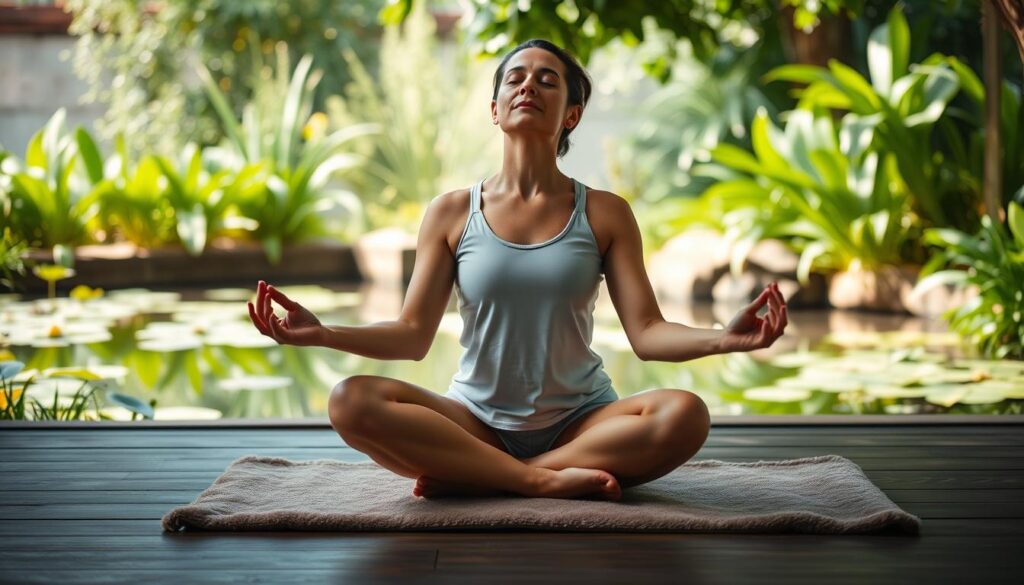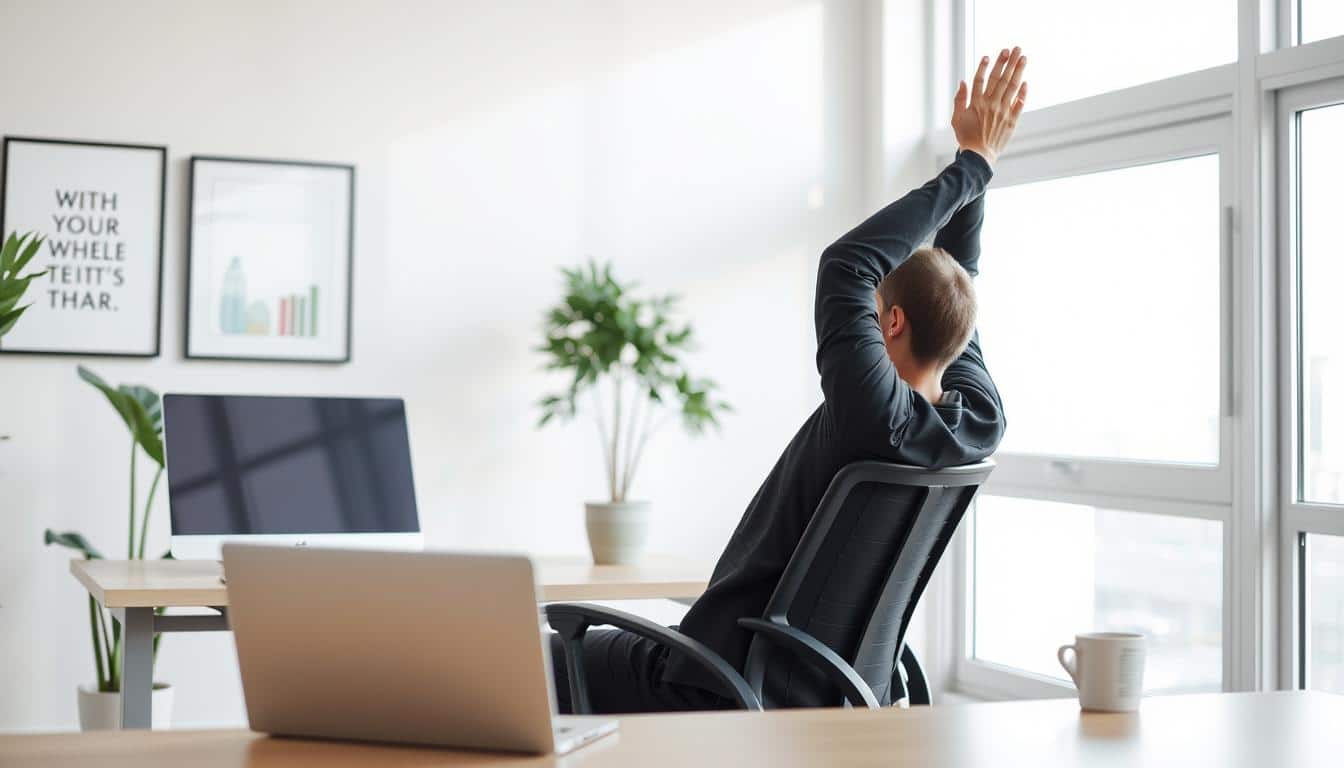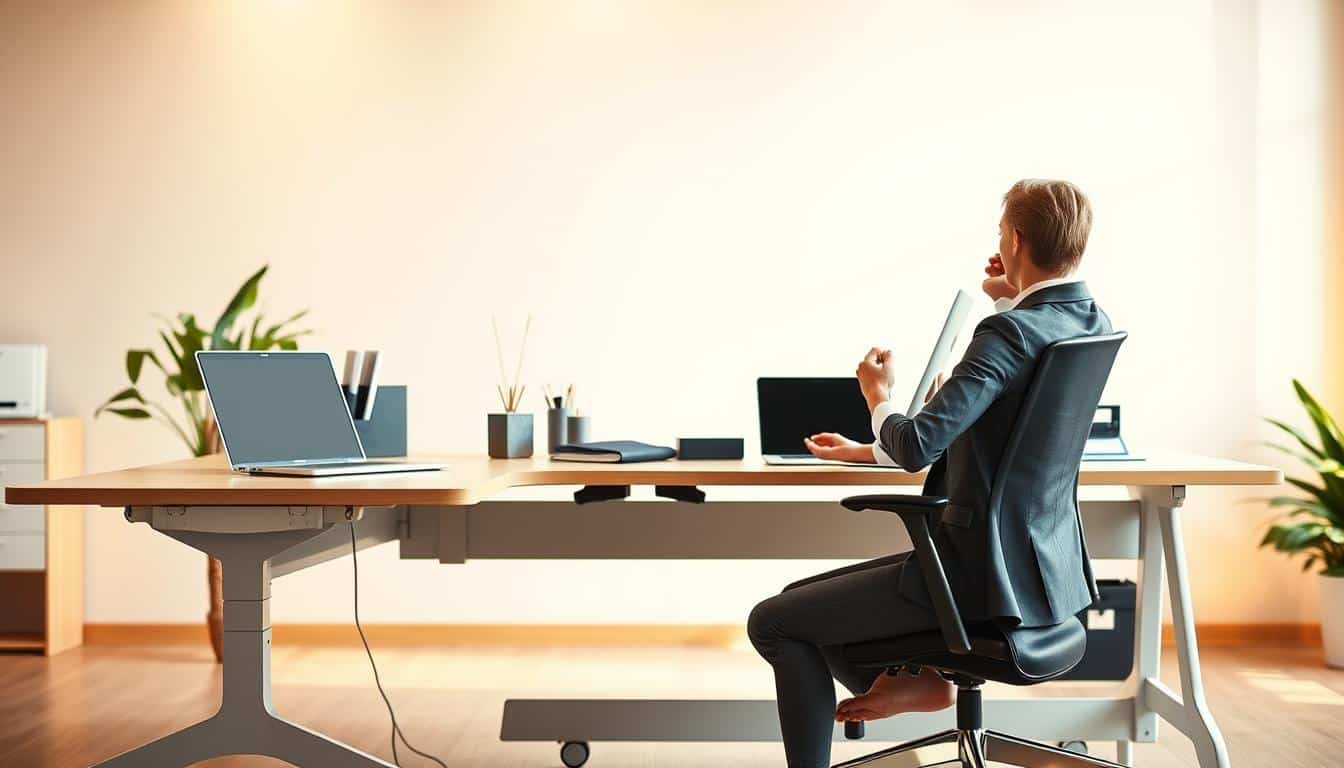Adding seated stretches to your day helps increase flexibility and relaxation. You can do these flexibility exercises while sitting in any chair or on a couch. This makes them perfect for everyone, especially those who sit a lot for work. Fitness expert Pete McCall says these stretches are key for staying physically healthy.
Doing seated stretches regularly helps loosen tight muscles and relieve back pain. They also make your joints move better. By using these relaxation moves, you’re improving your overall health. So, whether you’re relaxing at home or busy at work, taking time to stretch can make you feel and work better.
Introduction to Seated Stretches
Seated stretches are key for improving flexibility, especially for those who struggle with floor exercises. They are perfect for any setting, like home or work. No special gear is needed, making them great for everyone.
The seated hamstring stretch helps lengthen muscles and eases lower back pain, which betters your posture. The seated figure-four stretch focuses on your hips and back, reducing strain from sitting too long. Ankle rolls, a simple move, make your ankles more flexible, helping with balance and walking.
Adding these exercises to your daily life offers many benefits. You’ll see increases in flexibility and less muscle tightness. Seated stretches also promote joint health and can be adjusted for any fitness level. Videos are a great help for learning how to do each stretch properly. Consistently doing these exercises improves health, calms the mind, and lowers injury risks.
Benefits of Seated Stretches for Daily Life
Seated stretches bring many perks that make daily life better. They not only make you more flexible and mobile but also help relieve stress. Adding these stretches to your daily habits can change how you feel and move all day.
Enhancing Flexibility and Mobility
Increasing flexibility and mobility are key advantages of seated stretches. Studies show these movements can widen your range of motion. This makes day-to-day activities easier and more fun. From the comfort of your seat, you can work various muscles and ease stiffness from sitting too long. Plus, you can do many of these stretches without leaving your desk, fitting smoothly into any work schedule.
Reducing Stress and Tension
Seated stretches are great for lessening stress and tension. Research proves that stretching at work can cut down discomfort. In fact, some findings report a pain decrease of as much as 72 percent. Targeting common stress spots like the neck, shoulders, and lower back can be really effective. Using breath work while stretching boosts relaxation and overall well-being. Doing these regularly promotes activity that lifts spirits and fights off tiredness.
Understanding the Importance of Regular Mobility Training
Regular mobility training is key to staying healthy and fit. Sitting too much can make you less flexible and more likely to get hurt. By doing mobility exercises every day, you’ll see benefits like better posture and less stiffness. Easy exercises like seated leg extensions and twists can help improve flexibility while sitting.
What’s great about this training is you can do it anywhere, which is perfect for people who can’t move around much. It makes your joints work better, which is important for lots of activities. A study in 2024 found that mobility training boosts athletic skills and lowers the chance of injuries in 20 out of 22 studies.
There are two main things that make mobility training work well: doing it regularly and balancing types of stretching. Short sessions every day are better than long ones once in a while. It’s also important to mix static and dynamic stretches the right way. Holding a stretch for too long can actually make you perform worse.
Mobility exercises also increase synovial fluid, which helps your joints move smoothly. This can lower the chance of damage, keeping your movements easy and fun. With all these positives, making mobility training a regular part of your life is a smart choice for staying active and healthy.
How Seated Stretches Promote Better Posture
Seated stretches are key to improving posture, crucial for health when sitting long hours. Bad posture leads to muscle and bone issues. Targeted stretches for the chest, shoulders, and back help correct imbalances and improve spinal health.
Child’s Pose helps stretch the spine, glutes, and hamstrings. It relieves back and neck tension, aiding spinal alignment. Cat-Cow pose boosts spinal movement, easing torso and shoulder tightness. This supports better posture. Thoracic spine rotations reduce chest tightness, increasing upper back mobility.
Isometric pulls make shoulder and upper back muscles stronger, vital for good sitting posture. Regular seated stretches reduce muscle pain and increase energy. This improves mental well-being. With steady practice, better posture can be seen in weeks.
Poor sitting posture leads to neck and back pain. It shows the need for stretch-based flexibility and relaxation. Strengthening the back and spine muscles is essential. A tip for better posture is to use a lumbar roll for lower back support.
The Thoracic Repeated Extension stretch, done with a foam roller, enhances thoracic mobility. It also reduces tension. The Pec Stretch, performed in a doorway, opens chest muscles. This helps fight the slouch of rounded shoulders.
Common Issues Addressed by Seated Stretches
Seated stretches are great for easing pains we get from sitting too long. They mainly help with back and neck pain. Many people face these problems because they sit a lot during the day. By doing some easy stretches right from your chair, you can feel much better. These moves target the spots that often hurt the most.
Alleviating Back and Neck Pain
For those of us who sit a lot, back and neck pain are common complaints. To fight this pain, there are specific stretches you can do. Here are some stretches that can make a big difference:
- Abdominal Bracing: Do this 10 times, holding for 10 seconds. It makes your core strong and improves your posture.
- Seated Forward Flexion Stretch: Try this 3 times, each for 30 seconds. It stretches your lower back and the back of your thighs.
- Seated Figure Four Stretch: This is done 3 times for 30 seconds each. It’s great for your hips and lower back when you cross your legs.
- Seated Knee to Opposite Shoulder Stretch: Do this three times for 30 seconds to ease lower back tightness.
- Chair-Edge Hamstring Stretch: By doing this 3 times for 30 seconds, you’ll stretch your thigh muscles well.
Combating the Effects of Sedentary Lifestyles
Doing stretches while you’re seated boosts blood flow and flexibility. This is especially helpful for older adults or anyone who can’t move around much. They don’t require standing up or lying down, making them very accessible. Some good tips for these stretches include:
- Choosing a chair that supports your lower back well and sitting upright.
- Warming up a bit before stretching to keep muscles from getting hurt.
- Paying attention to what your body says and not stretching too far.
- Talking to a doctor before you start stretching, especially if you have health issues.
Essential Seated Stretches for Flexibility
Adding essential seated stretches into your day helps improve flexibility and lessen tension. These activities mainly target the neck and shoulders. They boost mobility and your overall health. Here are some top stretches you can do in a chair to get the most out of them and stay safe.
Ear-to-Shoulder Stretch
Sit up tall, keeping your back straight. Gently tilt your head to one side, ear moving towards your shoulder. Place your hand on your head for extra support. Hold for 15 to 30 seconds to stretch your neck’s side. Then, go back to the start and do it on the other side. This stretch eases neck tension and improves motion range.
Chin-to-Chest Stretch
Start by sitting straight and relaxing your shoulders. Lower your chin slowly to your chest to stretch your neck’s back. Stay like this for 15 to 30 seconds, taking deep breaths. Keep your shoulders low as you stretch. This move increases flexibility and helps drop stress built up during the day.
Active Shoulder Roll
Relax your arms by your sides while sitting. Breathe in deeply and lift your shoulders up towards your ears. As you exhale, roll them back and down in a circle. Do this 5 to 10 times to lessen shoulder tension. This action not only makes your shoulders more flexible but also aids in better posture.
Safety Tips for Performing Seated Stretches
Ensuring your safety while stretching is key to getting good results and not hurting yourself. It’s important to follow these tips for seated stretches to improve your flexibility safely.
- Warm up your muscles before stretching by walking for 3-5 minutes or doing arm circles.
- Stretch only to the point of tension, not pain, and hold each stretch for 20-30 seconds.
- Avoid bouncing during stretches to prevent muscle injury.
- Breathe deeply and evenly; inhale before starting the stretch and exhale during the stretch.
- Perform stretches slowly and carefully to maintain control and reduce injury risk.
- Strengthen abdominals to avoid arching your back, particularly during the Pec Corner Stretch.
- During the Chair Rotation Stretch, pull gently to increase stretch without causing discomfort.
- Ensure your shoulders remain relaxed during Forearm Stretches for optimal effectiveness.
- Consistency is key; aim to stretch 2-3 times per week for best results.
- Always stop if stretches become painful and consult a healthcare professional if necessary.
- Avoid overstretching the same muscle groups multiple times a day to prevent damage.
- Engage in 5 to 10 minutes of light cardio prior to stretching to effectively prepare cold muscles.
Seated Stretching Techniques to Incorporate at Work
Adding stretching to your workday can up your comfort and output. Desk exercises reduce stress, better your posture, and help blood circulation. Moving regularly keeps relaxation high and discomfort low. Easy stretches make for a healthier workplace.
Desk-Friendly Movements
Here are seated stretches for work:
- Trunk Rotation Stretch: Sit straight, feet flat, and twist slowly to one side. Hold for 10 seconds on each side.
- Chest Opener Stretch: Sit at your chair’s edge, hold the back, and push your chest out, shoulders back. Hold for 10 seconds and do it three times.
- Upper Body Stretch: Sit straight, lift interlocked hands above your head, palms up. Hold 10 seconds and repeat.
- Hamstring Stretch: Stretch one leg out, other foot flat, and reach for your toes. Hold for 30 seconds and switch legs.
- Neck Stretch: Grab your chair’s side, turn your head away, and hold for 10 seconds. Do it three times each side.
The Importance of Breaks and Ergonomics
Regular breaks keep you productive and ease muscle strain. A timer can remind you to stretch during the day, good for your ergonomics. A well-set workstation aids in maintaining a healthy posture and avoiding pain. Add these stretches to your day:
- One Arm Hug: Cross an arm over to the opposite shoulder, press the elbow back. Hold for 30 seconds, repeat 2-3 times each arm.
- Office Chair Back Stretch: Sitting, reach behind you, arch your back, and push the chest forward. Hold for 30 seconds, repeat five times.
- Wrist Stretch: Press palms together in front of you for 15 seconds, then press backs of hands together for 15 seconds. Repeat five times.
Combining Seated Stretches with Other Practices
Mixing seated stretches with different practices boosts both your physical and mental health. It’s all about matching techniques that work well together for a full effect. One key mix is using breathing exercises while you stretch. This helps you relax more and get more from your sessions.
Integrating Breathing Exercises
Adding breathing to stretches makes you focus on both your body and mind. Making things simpler can really boost your relaxation and help with stress. Try these steps:
- Incorporate deep breathing techniques throughout your stretches, allowing the breath to guide movements.
- Execute every seated stretch, including the Cable Stretch and Side Bend: Neck Stretch, with controlled inhalations and exhalations.
- Apply pauses during each stretch to emphasize breath awareness, fostering a calm environment.
- Use a resistance band during seated stretches like the Shoulder Shrug to amplify engagement and flexibility.
Starting with warm-up exercises before stretching helps make you more flexible and lowers the chance of getting hurt. Lying on the floor with a pillow under your knees also makes you more relaxed and improves your stretching. A full session should last 10-15 minutes, letting you do each movement 10-12 times. By blending controlled breathing and stretching, you create a deeper body connection and make each stretch better.

Conclusion
Adding seated stretches to your daily life brings big benefits. They improve your physical health, make you more flexible, and help you relax. Doing simple stretches like the Seated Hamstring Stretch for 20 seconds can loosen your muscles and increase movement. Regularly doing these stretches reduces lower back pain and helps with good posture and balance. This makes your daily activities more enjoyable.
To get the best results, stretch slowly and with correct posture. Remember to breathe deeply while stretching. Stretching for 10-30 seconds, several times a week, greatly boosts flexibility and muscle healing. Seated stretches become key in reducing stress and increasing well-being, no matter if you’re at work or home.
Staying consistent with stretching is crucial for better health. These easy but impactful activities lead to a healthier life. They enhance not just your body’s capabilities but also your life’s quality. Start doing seated stretches to transform both your body and mind.



